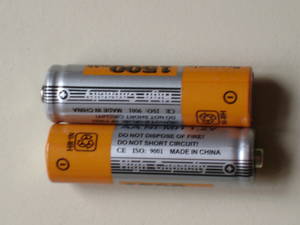Storing energy using nanopillars
Interview with
Sang - My name is Sang Bok Lee, and I'm a Professor of Chemistry at the University of Maryland. Basically this gadget is a very thin film and inside that thin film - about 20 microns thick - there are millions and millions of nano-scale pillars. And each individual nanopillar is composed of two different materials as coaxial structures.
Chris - So one inside the other - you've got one wrapped around the outside of a chemical inside. So what's on the inside of these pillars?
Sang - So the inside core is manganese oxide, which is a famous battery material. And the outer shell material is a conductive polymer. So each material has its own function. They can help each other synergistically to maximise energy storage properties, in this case.
 Chris - So how does it actually work as an energy storage vessel? How do you put energy in?
Chris - So how does it actually work as an energy storage vessel? How do you put energy in?
Sang - Basically, how I put the energy in is to apply a voltage, just like charging a battery.
Chris - And chemically, when you connect that to a battery, like you did with your stopwatch for 5 seconds [in a demonstration earlier], what did the current flowing into the thin film to do it?
Sang - Right, applying the voltage will oxidise these materials, changing their oxidation state to a different state. After you disconnect this charging process, now it has a stored electrical energy here. Now if you reconnect to another device like the stopwatch here, it releases its stored charge to the device, and makes the device work.
Chris - What are you trying to solve by doing this like this? Why do you think these are a useful design?
Sang - An important thing of the design of this device is the high power. As you know, the lithium ion itself has a high energy density, but pretty low power density. But we need high powers these days. For example, renewable energies like sunlight or wind-turbines - they produce energy intermittently. So if you use just a lithium ion battery to store the energy from the wind turbinethen you actually lose a lot of peak spike energy- you cannot store it all. However, using a high power device like this one, you can actually scavenge all those peak power energies from the wind-turbine or solar cells and so on.
Chris - So how are you actually doing that? What is it about this design that enables you to do that?
Sang - Things. One is it's nano-scale. Nano means it's really tiny so that ion transport through the nano-scale structures is really fast. Fast means high current, so high power. The other thing is two different materials, so each material has their own function and they help each other synergistically to deliver these fast ion and electron transfers.
Chris - So when you describe this as a coaxial structure with this conducting polymer around the manganese oxide in the middle, because they are very small scale structures you've got lots of surface contact. Is that how you were able to get these very high currents flowing so that you can have this peak power?
Sang - That's correct, pretty much. About 70, maybe 80% correct. Another feature is since the total diffusion or transport path length of these ions in the nano-scale is really short, so it happens really quick. That's why.
Chris - I see the stop-watch that you're powering with this from a 5 second charge up of this thing that just looks like a microscope slide - very very thin - is still running. Obviously that's a very low current device. But how long till you can scale this up so you can run big devices like a laptop rather than a stopwatch with it?
Sang - Right now, as a chemist, we haven't thought deeply about the larger-scale. However we're working on how we'll make this device scale up. The size we are imagining is about 1 metre by 1 metre, so it could easily deployed to large powered devices.
Chris - How do you make this? Is it easy?
Sang - It's very very simple. We're using a very thin membrane that has cylindrical pores - self aligned. You fill up the material inside the pore, then you just remove the template, then you have billions of pillars on the surface.
Chris - So it's very simple to fabricate - you could scale this relatively easily?
Sang - I guess so
Chris - And, timescale?
Sang - Right now, we're in the process of forming a company, so I will say 5 years.
Chris - Sang Bok Lee. And that stop-watch was still running 10 minutes later following a 5 second charge of that tiny battery that literally resembled a piece of film.










Comments
Add a comment